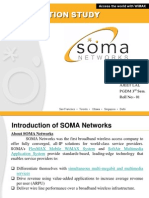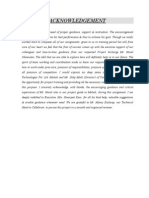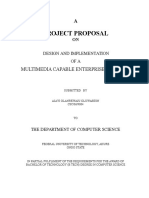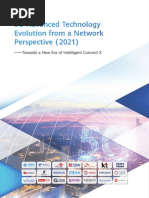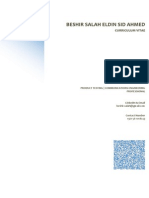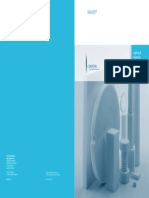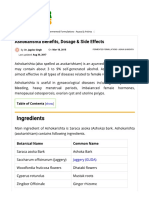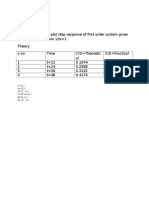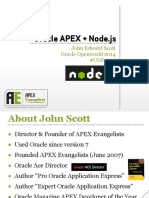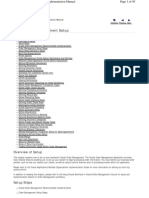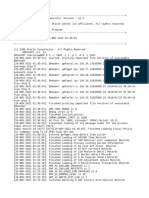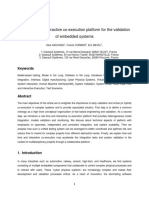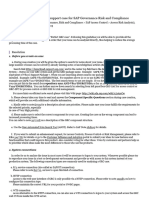Nokia Solutions and Networks Jaipur (Raj.) : Seminar Report ON Industrial Training AT
Nokia Solutions and Networks Jaipur (Raj.) : Seminar Report ON Industrial Training AT
Uploaded by
ragvshahCopyright:
Available Formats
Nokia Solutions and Networks Jaipur (Raj.) : Seminar Report ON Industrial Training AT
Nokia Solutions and Networks Jaipur (Raj.) : Seminar Report ON Industrial Training AT
Uploaded by
ragvshahOriginal Description:
Original Title
Copyright
Available Formats
Share this document
Did you find this document useful?
Is this content inappropriate?
Copyright:
Available Formats
Nokia Solutions and Networks Jaipur (Raj.) : Seminar Report ON Industrial Training AT
Nokia Solutions and Networks Jaipur (Raj.) : Seminar Report ON Industrial Training AT
Uploaded by
ragvshahCopyright:
Available Formats
A
SEMINAR REPORT
ON
INDUSTRIAL TRAINING
AT
Nokia Solutions and Networks
Jaipur (Raj.)
SUBMITTED IN PARTIAL FULFILLMENT OF REQUIREMENTS
FOR THE DEGREE OF
BACHELOR OF TECHNOLOGY
IN DEPARTMENT OF
ELECTRONICS AND COMMUNICATION ENGINEERING
Submitted to: Submitted by:
Mr. Ram gopal Raj Singh
Mr. Pappu Sharma VII Sem (B)
Asst. Professor 08EGJEC059
Department of Electronics & Communication Engineering
GLOBAL INSTITUTE OF TECHNOLOGY, JAIPUR
Rajasthan Technical University, Kota
June, 2012
ACKNOWLEDGMENT
I am highly indebted to all the Faculties and HOD, and is obliged for
giving me the autonomy of functioning and experimenting with ideas.
I would like to take this opportunity to express our profound gratitude
to them not only for their academic guidance but also for their
personal interest in our project and constant support coupled with
confidence boosting and motivating sessions which proved very
fruitful and were very instrumental in infusing self-assurance and trust
within us.
The nurturing and blossoming of the present work was mainly due to
their valuable guidance, suggestions, astute judgment, constructive
criticism and an eye for perfection.
Finally I am grateful to our friends and colleagues, whose constant
encouragement served to renew our spirit, refocus our attention and
energy and helped us in carrying out this work.
Raj Singh
DECLARATION
I, Ruhi Singh, a student of B.TECH 4
th
Year, studying at GLOBAL
INSTITUTE OF TECHNOLOGY, JAIPUR, hereby declare that the
summer training report submitted to Nokia Solutions and Networks,
JAIPUR, in partial fulfillment of Degree of B.TECH is the original
work conducted by me.
The information and data given in the report is authentic to the best of
my knowledge.
This summer training report is not being submitted to any other
university for any other degree, diploma and fellowship.
Raj Singh
ABSTRACT
This report is based on the GSM networking and network architecture
section of communication giant Nokia Solutions and Networks .The
report flashes the light on types of networks, planning, optimization,
the transmission of the signal and its whole signaling process for
various telecom giants is done and maintained by NOKIA. There are
five sections in the department works in the field of communication it
facilities Customer care support, Device management, Fixed-mobile
convergence, Hosting, Integrated provisioning ,Inventory
management, IPTV .Mobile backhaul Mobile ,TV Outsourcing,
Unified charging and billing, WCDMA frequency reframing, Optical
multiplexers. The Global System for Mobile Communications (GSM)
is a set of recommendations and specifications for a digital cellular
telephone network. These recommendations ensure the compatibility
of equipment from different GSM manufacturers, and
interconnectivity between different administrations, including
operation across international boundaries. GSM networks are digital
and can cater for high system capacities. They are consistent with the
world-wide digitization of the telephone network, and quality. Full
consideration must also be given to cost and spectrum allocation
limitations. A properly planned system should allow capacity to be
added economically when traffic demand increases. As every urban
environment is different, so is every macro cell and microcell
network. Hence informed and accurate planning is essential in order
to ensure that the system will provide both the increased capacity and
the improvement in network quality where required, especially when
deploying Microcellular systems.
TABLE OF CONTENTS
Title Page No.
Front Page...1
ACKNOWLEDGMENT...2
DECLARATION......3
ABSTRACT.....4
TABLE..5
Nokia Solutions and Networks AND ITS HISTORY.6-8
GSM SERVICES9-14
MS SERVICES......15-16
RF PLANNING AND OPTIMIZATION.....17-20
TRANSMISSION AND OPTIMIZATION ..21-23
TRANSMISSION..24
IN, VAS AND NSS.......25-30
BSS..31-32
OPERATION AND MAINTENANCE CENTRE..33-34
GPRS SYSTEM ..........35-36
OSS..37-40
PROJECT MANAGEMENT .....41
SECURITY42-49
BIBLIOGGRAPHY.........51
NOKIA SOLUTIONS AND NETWORKS
Address:-
1
st
& 2
nd
Floor, UDB Landmark, Building No A-6
Tonk road, Gopalpura Crossing, Jaipur-302018
NOKIA SOLUTIONS AND NETWORKS
Nokia Solutions and Networks (NSN),
currently the network business division of Nokia
Corporation, and formerly Nokia Siemens Networks, is a multinational data networking
and telecommunications equipment company headquartered in Espoo, Finland, and wholly
owned subsidiary of Nokia Corporation.
It was a joint venture between Nokia of Finland and Siemens of Germany known as Nokia
Siemens Networks. NSN has operations in around 150 countries. In 2013, Nokia acquired
100% of the company, with a buy-out of Siemens AG.
In April 2014 it was announced the
NSN name will be phased out.
HISTORY
The company was created as the result of a joint venture between Siemens
Communications division (minus its Enterprise business unit) and Nokia's Network Business
Group. The formation of the company was publicly announced on 19 June 2006. Nokia
Siemens Networks was officially launched at the 3GSM World Congress in Barcelona in
February 2007. Nokia Siemens Networks then began full operations on 1 April 2007 and has
its headquarters in Espoo, Greater Helsinki, Finland. As of 2009, according to Siemens,
Siemens only retained a non-controlling financial interest in NSN, with the day-to-day
operations residing with Nokia.
In January 2008 Nokia Siemens Networks acquired Israeli company Atrica, a company that
builds carrier-class Ethernet transport systems for metro networks. The official release did
not disclose terms, however they are thought to be in the region of $100 million. In February
2008 Nokia Siemens Networks acquired Apertio, a Bristol, UK-based mobile network
customer management tools provider, for 140 million.. After the restructuring process,
Nokia Siemens Networks has brought in a positive turn around to its businesses. The bottom
line and operating margins have risen to approximately 10%, which is a significant shift from
the previous sub-zero margins, with positive cash flows for the last six quarters.
On 7 August 2013, the company completed the acquisition of Siemens' stake and renamed as
"Nokia Solutions and Networks". After this acquisition NSN is fully owned by Nokia.
On 29 April 2014, Nokia Corporation announced that NSN will henceforth be known as
the Networks business of the company. It was also announced that Rajeev suri, the CEO of
NSN is appointed as President and CEO of Nokia Corporation, effective May 1, 2014.
OPERATIONS
Nokia Solutions Networks operates in more than 150 countries worldwide and has about
58,400 employees (end 2012). Most of those employees work in one of the six central hubs
around the world, including: Espoo in Finland, Munich in Germany, Budapest in
Hungary, Wrocaw and Cracow in Poland, Chennai and Bangalore inIndia, Guangdong in Ch
ina and Lisbon in Portugal.
Its major manufacturing sites are in Chennai in India, China, Oulu in Finland, and in Berlin,
Germany.
Rajeev Suri is the current Chief Executive Officer of Nokia Solutions Networks. In this
position he succeeds Simon Beresford-Wylie, who stepped down (1 October 2009) after
leading the company's integration.
Nokia Solutions Networks' Chief Financial Officer (CFO) is Samih Elhage. Prior to this, in
March 2012, Samih Elhage was appointed Chief Operating Officer, reporting to Rajeev Suri.
With effect from February 2013, the post of COO was discontinued.
The Chairman of the board of directors is now Jesper Ovesen, previous chairman was Nokia's
former CEO Olli-Pekka Kallasvuo, vice chairman is Rudi Lamprecht (Executive Advisor to
the CEO of Siemens AG).
BUSINESS UNITS
Nokia Solutions Networks has organised its operations into the following business units:
Mobile Broadband (MBB)
Global Services (GS)
GSM SERVICES
Global system for mobile communications (GSM)
A mobile communication standard
GSM communication uses cellular networks
The GSM standard operates in the frequency ranges of 900, 1800, and 1900 MHz
Tri-band (operable in GSM 900/1800/1900) phones enable easy international roaming in
GSM networks
GSM is a second generation (2G) communication standard
CONNECTION
Establishes between two TEsthe source and the destination
The destination TE may or may not belong to a GSM network
INTERFFACES
A mobile terminal acts as an interface between a communications network (for example,
interface between the GSM public land mobile network) and terminal, TE the source or
destination of the service.
The TE used by a caller to connect and communicate and MT for mobile communication.
CONNECTION
Depends on the sourcedestination network which may be a GSM, PSTN
(public switched telephone network), ISDN (integrated services digital network),
PSPDN (public switched public data network), or any other network carrying
the data to the end-point TE
CONNECTION FROM CALLER
A caller TE transmits through interface 1 to a GSM public land mobile network
Through 2 to a PSTN network
Through 3 to a sourcedestination network
Through 4 to a terminal or mobile station TE
In place of the PSTN network, there may be an ISDN or PSPDN network
Three types of integrated services for voice and data
Teleservices
Supplementary services
Bearer services
TELESERVICES
Services offered by a mobile-service network to a caller (TE)
Telephonic-voice at full data rate (13.4 kbps)
Fax, SMS
Emergency number 112 for emergency calls
MMS [supporting GIF, JPG, WBMP, teletext, and videotext access (GIF, JPG,
and WBMP are formats of files that store pictures)]
Point-to-point from a TE to another TE A point-to-point service is implemented using
cellular communication of a voice signal
GSM ARCHITECTURE
ADDITIONAL TELESERVICES
Half data-rate speech or enhanced full-rate speech services, and these may or may not be
rendered by cellular and point-to-point access systems
A GSM smart phone, which connects to a GSM public land mobile network
A number of tele-services including phone, voice data (for example, recorded message
played on auto-answer of incoming calls), SMS, and MMS to another GSM or PSTN
network
Caller line forwarding (redirection), caller line identification
Line identification to the caller
Closed user group formation
Multiparty groupings (e.g., in an enterprise)
Call holding, call waiting, and barring calls from specified numbers or groups
Restricted provisioning of certain services to the users
Internet and email access granted on special requests from users)
Providing information regarding call charges, remaining phone account etc.
BEARER SERVICES
Each TE has a user interface
The interface (1, 8) of a mobile station connects the MT to a GSM public land
mobile network
The interface (4, 5) of a PSTN phone connects to a PSTN network Bearer Services
An intermediate PSTN network acts as an interface for a GSM public land mobile network
In place of PSTN, there may be ISDN, PSPDN, or some other network Bearer service
(service through the interfaces)
(a) transparent and uses data rates of 2.4 kbps, 4.8 kbps, or 9.6 kbps or
(b) non-transparent and uses lower data rates (300 bps to 9.6 kbps)
MOBILE STATION SERVICES
A mobile station (MS) comprises all user equipment and software needed for
communication with a mobile network.
The term refers to the global system connected to the mobile network, i.e. a
mobile phone or mobile computer connected using a mobile broadband adapter.
This is the terminology of 2G systems like GSM. In 3G systems, a mobile station
(MS) is now referred to as user equipment (UE).
In GSM, a mobile station consists of four main components:
Mobile termination (MT) - offers common functions of a such as: radio
Transmission and handover, speech encoding and decoding , Error detect ion and
correction , signalling and access to the SIM. The IMEI code is attached to the MT.
It is equivalent to the network termination of an ISDN access.
Terminal equipment (TE) - is any device connected to the MS offering
services to the user. It does not contain any functions specific to GSM.
Terminal adapter (TA) - Provides access to th e MT as if it was an ISDN
network termination with extended capabilities. Communication between the TE
and MT over the TA takes place using commands.
Subscriber identity module (SIM) - is a removable subscriber
identification token storing the IMSI a unique key shared with the mobile network
operator and other data.
In a mobile phone, the MT, TA and TE are enclosed in the same case. However,
the MT and TE functions are often performed by distinct processors. The application
processor serves as a TE, while the baseband processor serves as a MT,
communication between both takes place over a bus using AT commands, Which
serves as a TA.
RF PLANNING AND OPTIMIZATION
In the context of mobile radio communication systems, RF Planning is the process of
assigning frequencies, transmitter locations and parameters of a wireless communications
system to provide sufficient coverage and capacity for the services required. The RF plan of a
cellular communication system has two objectives: coverage and capacity. Coverage relates
to the geographical footprint within the system that has sufficient RF signal strength to
provide for a call/data session. Capacity relates to the capability of the system to sustain a
given number of subscribers. Capacity and coverage are interrelated. To improve coverage,
capacity has to be sacrificed, while to improve capacity, coverage will have to be sacrificed.
INITIAL RADIO LINK BUDGETING
The first level of the RF planning process is a budgetary level. It uses the RF Link
Budget along with a statistical propagation model (e.g. Hata, COST-231 Hata or Erceg-
Greenstein) to approximate the coverage area of the planned sites and to eventually determine
how many sites are required for the particular RF communication system. The statistical
propagation model does not include terrain effects and has a slope and intercept value for
each type of environment (Rural, Urban, Suburban, etc.). This fairly simplistic approach
allows for a quick analysis of the number of sites that may be required to cover a certain area.
DETAILED RF PROPAGARION MODELLING
The second level of the RF Planning process relies a more detailed propagation model.
Automatic planning tools are often employed in this phase to perform detailed predictions.
The propagation model takes into account the characteristics of the selected antenna, the
terrain, and the land use and land clutter surrounding each site. Since these factors are
considered, this propagation model provides a better estimate of the coverage of the sites than
the initial statistical propagation model. Thus, its use, in conjunction with the RF link budget,
produces a more accurate determination of the number of sites required. Following is a
typical list of outputs produced at this stage:
Number of Sites and Site Locations (and Height)
Antenna Directions and Downtilts
Neighbour Cell Lists for each site
Mobility (Handover and Cell Reselection) Parameters for each site.
Frequency Plan
Detailed Coverage Predictions (e.g. Signal Strength (RSRP), Signal Quality (RSRQ) Best
CINR, Best Server Areas, Uplink and Downlink Throughput)
FINE TUNING AND OPTIMIZATION
The third phase of the RF planning process incorporates further detail into the RF plan. This
stage includes items such as collecting drive data to be used to tune or calibrate the
propagation prediction model, predicting the available data throughput at each site, fine
tuning of parameter settings (e.g. antenna orientation, downtilting, frequency plan). This
process is required in the deployment of the system or in determining service contract based
coverage. Following is a typical list of outputs produced at this stage:
A final List of Sites and Site Locations (and Height)
Optimised Antenna Directions and Downtilts
An optimised Neighbour Cell Lists for each site
Mobility (Handover and Cell Reselection) Parameters for each site.
An optimised Frequency Plan
Detailed Coverage Predictions (e.g. Signal Strength (RSRP), Signal Quality (RSRQ) Best
CINR, Best Server Areas, Uplink and Downlink Throughput)
CONTINUOUS OPTIMIZATION
The final phase of the RF planning process involves continuous optimisation of the RF plan
to accommodate for changes in the environment or additional service requirements (e.g.
additional coverage or capacity). This phase starts from initial network deployment and
involves collecting measurement data on a regular basis that could be via drive testing or
centralised collection. The data is then used to plan new sites or to optimize the parameter
settings (e.g. antenna orientation, downtilting, frequency plan) of existing sites.
FREQUENCY PLANNING
The main goal of the frequency-planning task is to increase the efficiency of the spectrum
usage, keeping the interference in the network below some predefined level. Therefore it is
always related to interference predictions.
There are two basic approaches to solve the frequency assignment problem. Frequency reuse
patterns
Automatic frequency allocation
Some softwares are used with automatic frequency allocation algorithms for finding the
optimum solutions. The frequency allocation is generally guided by the following
information:
Channel requirement on cell basis according to the capacity planning
Channel spacing limitations according to BTS specification
Quality of service requirement which is conserved to acceptable interference probability
Traffic density distribution over the service area
Performance of advanced system features (frequency hopping, IUO, etc.)
The frequency allocation is based on cell-to-cell interference probability estimation
according to the network topology, field strength distribution and traffic load. This results in
customized frequency performance of the selected radio network elements.
TRANSMISSION AND OPTIMIZATION
Microwave transmission refers to the technology of transmitting information or energy by the
use of radio waves whose wavelengths are conveniently measured in small numbers of
centimetre; these are called microwaves. This part of the radio spectrum ranges
across frequencies of roughly 1.0 gigahertz (GHz) to 30 GHz. These correspond to
wavelengths from 30 cms down to 1.0 cm.
The atmospheric attenuation of microwaves in dry air with a precipitable water vapor level
of 0.001 mm. The downward spikes in the graph correspond to frequencies at which
microwaves are absorbed more strongly, such as by oxygen molecules.
USES
Microwaves are widely used for point-to-point communications because their
small wavelength allows conveniently-sized antennas to direct them in narrow beams, which
can be pointed directly at the receiving antenna. This allows nearby microwave equipment to
use the same frequencies without interfering with each other, as lower frequency radio waves
do. Another advantage is that the high frequency of microwaves gives the microwave band a
very large information-carrying capacity; the microwave band has a bandwidth 30 times that
of all the rest of the radio spectrum below it. A disadvantage is that microwaves are limited
to line of sight propagation; they cannot pass around hills or mountains as lower frequency
radio waves can.
Microwave radio transmission is commonly used in point-to-point communication
systems on the surface of the Earth, in satellite communications, and in deep space radio
communications. Other parts of the microwave radio band are used for radars, radio
navigation systems, sensor systems, and radio astronomy.
The next higher part of the radio electromagnetic spectrum, where the frequencies are above
30 GHz and below 100 GHz, are called " millimeter waves" because their wavelengths are
conveniently measured in millimeters, and their wavelengths range from 10 mm down to
3.0 mm. Radio waves in this band are usually strongly attenuated by the Earthly
atmosphere and particles contained in it, especially during wet weather. Also, in wide band of
frequencies around 60 GHz, the radio waves are strongly attenuated by molecular oxygen in
the atmosphereWireless transmission of information
One-way (e.g. television broadcasting) and two-way telecommunication
using communications satellite
Terrestrial microwave radio broadcasting relay links in telecommunications networks
including e.g. backbone or backhaul carriers in cellular networks linking BTS-BSC and
BSC-MSC.
Wireless transmission of power
Proposed systems e.g. for connecting solar power collecting satellites to terrestrial power
grid
MICROWAVE LINK
A microwave link is a communications system that uses a beam of radio waves in the
microwave frequency range to transmit video, audio, or data between two locations, which
can be from just a few feet or meters to several miles or kilometers apart. Microwave links
are commonly used by television broadcasters to transmit programmes across a country, for
instance, or from an outside broadcast back to a studio.
Mobile units can be camera mounted, allowing cameras the freedom to move around without
trailing cables. These are often seen on the touchlines of sports fields on Steady cam systems
MICROWAVE RADIO RELAY
Microwave radio relay is a technology for transmitting digital and analog signals, such as
long-distance telephone calls, television programs, and computer data, between two locations
on a line of sight radio path. In microwave radio relay, microwaves are transmitted between
the two locations with directional antennas, forming a fixed radio connection between the two
points. The requirement of a line of sight limits the distance between stations to 30 or 40
miles.
Beginning in the 1940s, networks of microwave relay links, such as the AT&T Long
Lines system in the U.S., carried long distance telephone calls and television programs
between cities. The first system, dubbed TD-2 and built by AT&T, connected New York and
Boston in 1947 with a series of eight radio relay stations. These included long daisy-
chained series of such links that traversed mountain ranges and spanned continents. Much of
the transcontinental traffic is now carried by cheaper optical fibers and communication
satellites, but microwave relay remains important for shorter distances.
How microwave radio relay links are formed??
Because the radio waves travel in narrow beams confined to a line-of-sight path from one
antenna to the other, they don't interfere with other microwave equipment, and nearby
microwave links can use the same frequencies. Antennas used must be
highly directional (High gain); these antennas are installed in elevated locations such as large
radio towers in order to be able to transmit across long distances. Typical types of antenna
used in radio relay link installations are parabolic antennas, dielectric lens, and horn-reflector
antennas, which have a diameter of up to 4 meters. Highly directive antennas permit an
economical use of the available frequency spectrum, despite long transmission distances.
TRANSMISSION
In telecommunications, transmission (abbreviation: Tx) is the process of sending and
propagating an analogue or digital information signal over a physical point-to-point or point-
to-multipoint transmission medium, either wired, optical fiber or wireless. Transmission
technologies and schemes typically refer to physical layer protocol duties such as modulation,
demodulation, line coding, equalization, error control, bit synchronization and multiplexing,
but the term may also involve higher-layer protocol duties, for example, digitizing an analog
message signal, and source coding (compression).
Antenna used for transmission of radio signal
Transmission of a digital message, or of a digitized analog signal, is known as data
transmission or digital communication.
One transmission is the sending of a signal with limited duration, for example a block or
packet of data, a phone call, or an email.
A parabolic satellite antenna for Erdfunkstelle Raisting, based in Raisting ,Bavaria, Germany.
INTELLIGENT NETWORK
The Intelligent Network (IN) is the standard network architecture specified in the ITU-T
Q.1200 series recommendations. It is intended for fixed as well as mobile telecom networks.
It allows operators to differentiate themselves by providing value-added services in addition
to the standard telecom services such as PSTN, ISDN and GSM services on mobile phones.
The intelligence is provided by network nodes on the service layer, distinct from
the switching layer of the core network, as opposed to solutions based on intelligence in the
core switches or telephone equipment. The IN nodes are typically owned
by telecommunications operators (telecommunications service providers).
IN is supported by the Signalling System #7 (SS7) protocol between telephone network
switching centres and other network nodes owned by network operators.
EXAMPLES OF IN SERVICES
Call screening
Telephone number portability
Prepaid calling
Account card calling
Virtual private networks (such as family group calling)
Centrex service (Virtual PBX)
Mass-calling service
Prefix free dialing from cell phone
FUTURE
While activity in development of IN standards has declined in recent years, there are many
systems deployed across the world which use this technology. The architecture has proved to
be not only stable, but also a continuing source of revenue with new services added all the
time. Manufacturers continue to support the equipment and obsolescence is not an issue.
Nevertheless, new technologies and architectures are emerging, especially in the area
of VoIP and SIP. More attention is being paid to the use of APIs in preference to protocols
like INAP and new standards have emerged in the form of JAIN and Parlay. From a technical
view, the SCE is beginning to move away from its proprietary graphical origins and is
moving towards a Java application server environment.
NETWORK SWITCHING SYSTEM
Network switching subsystem (NSS) (or GSM core network) is the component of
a GSM system that carries out call switching and mobility management functions for mobile
phones roaming on the network of base stations. It is owned and deployed by mobile phone
operators and allows mobile devices to communicate with each other and telephones in the
wider public switched telephone network (PSTN). The architecture contains specific features
and functions which are needed because the phones are not fixed in one location.
The NSS originally consisted of the circuit-switched core network, used for traditional GSM
services such as voice calls, SMS, and circuit switched data calls. It was extended with an
overlay architecture to provide packet-switched data services known as the GPRS core
network. This allows mobile phones to have access to services such as WAP, MMS, and
the Internet.
MOBILE SWITCHING CENTRE
The mobile switching center (MSC) is the primary service delivery node for GSM/CDMA,
responsible for routing voice calls and SMS as well as other services (such as conference
calls, FAX and circuit switched data).
The MSC sets up and releases the end-to-end connection, handles mobility and hand-over
requirements during the call and takes care of charging and real time pre-paid account
monitoring.
The Gateway MSC (G-MSC) is the MSC that determines which visited MSC the subscriber
who is being called is currently located at. It also interfaces with the PSTN. All mobile to
mobile calls and PSTN to mobile calls are routed through a G-MSC. The term is only valid in
the context of one call since any MSC may provide both the gateway function and the Visited
MSC function, however, some manufacturers design dedicated high capacity MSCs which do
not have any BSSs connected to them. These MSCs will then be the Gateway MSC for many
of the calls they handle.
The visited MSC (V-MSC) is the MSC where a customer is currently located.
The VLR associated with this MSC will have the subscriber's data in it.
The anchor MSC is the MSC from which a handover has been initiated. The target MSC is
the MSC toward which a Handover should take place. A mobile switching centre server is a
part of the redesigned MSC concept starting from 3GPP Release
MOBILE SWITCHING SERVER CENTRE (MSCS)
The mobile switching centre server is a soft-switch variant of the mobile switching centre,
which provides circuit-switched calling mobility management, and GSM services to the
mobile phones roaming within the area that it serves. MSS functionality enables split between
control (signalling) and user plane (bearer in network element called as media gateway/MG),
which guarantees better placement of network elements within the network.
MSS and MGW media gateway makes it possible to cross-connect circuit switched calls
switched by using IP, ATM AAL2 as well as TDM. More information is available in 3GPP
TS 23.205.
HOME LOCATION REGISTER
The home location register (HLR) is a central database that contains details of each mobile
phone subscriber that is authorized to use the GSM core network. There can be several
logical, and physical, HLRs per public land mobile network (PLMN), though
one international mobile subscriber identity (IMSI)/MSISDN pair can be associated with only
one logical HLR (which can span several physical nodes) at a time.
The HLRs store details of every SIM card issued by the mobile phone operator. Each SIM
has a unique identifier called an IMSI which is the primary key to each HLR record.
AUTHENTICATION REGISTER
The authentication centre (AUC) is a function to authenticate each SIM card that attempts
to connect to the GSM core network (typically when the phone is powered on). Once the
authentication is successful, the HLR is allowed to manage the SIM and services described
above. An encryption key is also generated that is subsequently used to encrypt all wireless
communications (voice, SMS, etc.) between the mobile phone and the GSM core network.
If the authentication fails, then no services are possible from that particular combination of
SIM card and mobile phone operator attempted. There is an additional form of identification
check performed on the serial number of the mobile phone described in the EIR section
below, but this is not relevant to the AUC processing.
Proper implementation of security in and around the AUC is a key part of an operator's
strategy to avoid SIM cloning.
VISITOR LOCATION REGISTER
The visitor location is a database of the subscribers who have roamed into the jurisdiction of
the MSC (Mobile Switching Center) which it serves. Each main base station in the network is
served by exactly one VLR( One BTS may be served by many MSCs in case of MSC in
pool), hence a subscriber cannot be present in more than one VLR at a time.
The data stored in the VLR has either been received from the HLR, or collected from the MS
(Mobile station). In practice, for performance reasons, most vendors integrate the VLR
directly to the V-MSC and, where this is not done, the VLR is very tightly linked with the
MSC via a proprietary interface. Whenever an MSC detects a new MS in its network, in
addition to creating a new record in the VLR, it also updates the HLR of the mobile
subscriber, apprising it of the new location of that MS. If VLR data is corrupted it can lead to
serious issues with text messaging and call services.
EQUIPMENT IDENTITY REGISTER
The equipment identity register is often integrated to the HLR. The EIR keeps a list of
mobile phones (identified by their IMEI) which are to be banned from the network or
monitored. This is designed to allow tracking of stolen mobile phones. In theory all data
about all stolen mobile phones should be distributed to all EIRs in the world through a
Central EIR. It is clear, however, that there are some countries where this is not in operation.
The EIR data does not have to change in real time, which means that this function can be less
distributed than the function of the HLR. The EIR is a database that contains information
about the identity of the mobile equipment that prevents calls from stolen, unauthorized or
defective mobile stations. Some EIR also have the capability to log Handset attempts and
store it in a log file.
IMSI
The International mobile Subscriber Identity or IMSI /mzi/ is used to identify the user
of a cellular network and is a unique identification associated with all cellular networks. It is
stored as a 64 bit field and is sent by the phone to the network. It is also used for acquiring
other details of the mobile in the home location register (HLR) or as locally copied in
the visitor location register.
The IMSI is used in any mobile network that interconnects with other networks.
An IMSI is usually presented as a 15 digit long number, but can be shorter.
VALUE ADDED SERVICES
A value-added service (VAS) is a popular telecommunications industry
term for non-core
services, or in short, all services beyond standard voice calls and fax transmissions. However,
it can be used in any service industry, for services available at little or no cost
to promote
their primary business.
In the telecommunication industry, on a conceptual level, value-added services add value to
the standard service offering, spurring the subscriber to use their phone more and allowing
the operator to drive up their ARPU. For mobile phones, technologies
like SMS, MMS and data access were historically usually considered value-added services,
but in recent years SMS, MMS and data access have more and more become core services,
and VAS therefore has begun to exclude those services.
Mobile VAS services can be mainly categorized into 3.
1. Consumer VAS
2. Network VAS
3. Enterprise VAS
Value-added services are supplied either in-house by the mobile network operator themselves
or by a third-party value-added service provider (VASP), also known as a content
provider (CP) such as All Headline News or Reuters.
MAJOR SERVICES UNDER VAS
Music Tracks Play, download and Ring Tones
Sports and Infortainment Services
Location Based Services
Missed Call Alerts and Voice Mail Box
Online Gaming
GLOBAL VAS COMPANIES
America Movil
CanvasM Technology Ltd
DMD Platform
Galactic Infotech Solutions
GoBindas Entertainment
BUSINESS SUPPORT SYSTEM
Business Support Systems (BSS) are the components that a telecommunications service
provider (or telco) uses to run its business operations towards customers.
Together with Operations Support Systems (OSS), they are used to support various end-to-
end telecommunication services (e.g., telephone services). BSS and OSS have their own data
and service responsibilities. The two systems together are often abbreviated OSS/BSS,
BSS/OSS or simply B/OSS.
The acronym BSS is also used in a singular form to refer to all the Business Support Systems
viewed as a whole system.
ROLE OF BSS
BSS deals with the taking of orders, payment issues, revenues, etc. It supports four
processes: product management, order management, revenue management and customer
management.
Product management
Product management supports product development, the sales and management of products,
offers and bundles to businesses and mass-market customers. Product management regularly
includes offering cross-product discounts, appropriate pricing and managing how products
relate to one another.
Customer management
Service providers require a single view of the customer and regularly need to support
complex hierarchies across customer-facing applications (customer relationship
management). Customer management also covers requirements for partner management and
24x7 web-based customer self-service. Customer management can also be thought of as full-
fledged customer relationship management systems implemented to help customer care
agents handle the customers in a better and more informed manner.
Revenue management
Revenue management focuses on billing, charging and settlement. It can handle any
combination of OSS services, products and offers. BSS revenue management supports OSS
order provisioning and often partner settlement. Billing is an integral function offered by BSS
systems and is not under the purview of OSS.
ORDER MANAGEMENT
Order management encompasses four areas:
Order decomposition details the rules for decomposing a Sales Order into
multiple work orders or service orders. For example, a Triple Play Telco Sales
order with three services - land line, Internet and wireless - can be broken down
into three sub-orders, one for each line of business. Each of the sub-orders will be
fulfilled separately in its own provisioning systems. However, there may be
dependencies in each sub-order; e.g., an Internet sub-order can be fulfilled only
when the land line has been successfully installed, provisioned and activated in
the customer premise.
Order orchestration is an objective application, developed under Oracle Fusion,
which is used by telcos to precisely manage, process and handle their customer
orders across a multiple fulfillment and order capture network. It helps in the data
aggregation transversely from assorted order capture and order fulfillment
systems and delivers an all-inclusive platform for customer order management. It
has been in vast application in the recent times, due to its advanced and precise
order information efficiency and low order fulfillment costs, thus aggregating
lesser manual process, and faster output. Its radical exception response based
functioning and proactive monitoring enables it to centralize order data in
accurate manner with ease.
Order fallout, also known as Order Failure, refers to the condition when an order
fails during processing. The order fallout occurs due to multiple scenarios; such as
downstream system failure, which relates to an internal non-data related error; or
when the system receives incorrect or missing data, which subsequently fails the
order. Other Order Fallout conditions include database failure or error pertaining
to network connectivity. Validation or recognition of order also occurs, in which
the system marks the received corrupted order from external system as failed.
Another Order Fallout condition refers to the state of run-time failure, wherein an
order is inhibited from getting processed due to non-determined reliance. Order
Fallout Management helps in complete resolve of order failures through detection,
notification and recovery process, helping the order to process sustain-ably and
precisely.
Order status management
Order management as a beginning of assurance is normally associated with
OSS, although BSS is often the business driver for fulfilment management
and order provisioning.
OPERATION AND MAINTENANCE
CENTRE
In mobile networks, an Operations and Maintenance Centre is the central location to
operate and maintain the network.
There are various types of OMCs depending on the functionality:
OMC-B (for maintaining Node B)
OMC-R (radio. for maintaining RNC)
UMTS OMC-U
GPRS OMC-G
OMC-DO
OMC-IP
PARAMETERS OF O&M
1. Flexibility
2. Integration
3. Quality
4. Experience
5. Professionalism
6. Manpower
7. Capability
GPRS
General packet radio service (GPRS) is a packet oriented mobile data service on
the 2G and 3G cellular communication system's global system for mobile
communications (GSM). GPRS was originally standardized by European
Telecommunications Standards Institute (ETSI) in response to the earlier CDPD and i-mode
packet-switched cellular technologies. It is now maintained by the 3rd Generation Partnership
Project (3GPP).
GPRS usage is typically charged based on volume of data transferred, contrasting with circuit
switched data, which is usually billed per minute of connection time. Usage above the bundle
cap is either charged per megabyte or disallowed.
GPRS is a best-effort service, implying variable throughput and latency that depend on the
number of other users sharing the service concurrently, as opposed to circuit switching,
where a certain quality of service is guaranteed during the connection. In 2G systems, GPRS
provides data rates of 56114 k bit/second. 2Gcellular technology combined with GPRS is
sometimes described as 2.5G, that is, a technology between the second (2G) and third (3G)
generations of mobile telephony. It provides moderate-speed data transfer, by using
unused time division multiple access (TDMA) channels in, for example, the GSM system.
GPRS is integrated into GSM Release 97 and newer releases.
SERVICES OFFERED
GPRS extends the GSM Packet circuit switched data capabilities and makes the following
services possible:
SMS messaging and broadcasting
"Always on" internet access
Multimedia messaging service (MMS)
Push to talk over cellular (POC)
Instant messaging and presencewireless village
Internet applications for smart devices through wireless application protocol (WAP)
Point-to-point (P2P) service: inter-networking with the Internet (IP)
Point-to-Multipoint (P2M) service
:
point-to-multipoint multicast and point-to-multipoint
group calls
OPERATION SUPPORT SYSTEM (OSS)
Operations Support Systems (OSS), or operational support systems in British usage, are
computer systems used by telecommunications service providers to manage their networks
(e.g., telephone networks). They support management functions such as network
inventory, service provisioning, network configuration and fault management.
Together with Business Support Systems (BSS), they are used to support various end-to-end
telecommunication services. BSS and OSS have their own data and service responsibilities.
The two systems together are often abbreviated OSS/BSS, BSS/OSS or simply B/OSS.
The acronym OSS is also used in a singular form to refer to all the Operations Support
Systems viewed as a whole system.
Different subdivisions of OSS have been proposed by the TM Forum, industrial research labs
or OSS vendors. In general, an OSS covers at least the following five functions:
Network management systems
Service delivery
Service fulfillment, including the network inventory, activation and provisioning
Service assurance
Customer care
OSS ELEMENTS
Here are some of the OMC functions:
Administration and commercial operation (subscription, end terminals, charging and
statistics).
Security Management.
Network configuration, Operation and Performance Management.
Maintenance Tasks.
OSS ARCHTECTURE
ARCHITECTURE
A lot of the work on OSS has been centered on defining its architecture. Put simply, there are
four key elements of OSS:
Processes
the sequence of events
Data
the information that is acted upon
Applications
the components that implement processes to manage data
Technology
how we implement the applications
During the 1990s, new OSS architecture definitions were done by the ITU
Telecommunication Standardization Sector (ITU-T) in its Telecommunications Management
Network (TMN) model. This established a 4-layer model of TMN applicable within an OSS:
Business Management Level (BML)
Service Management Level (SML)
Network Management Level (NML)
Element Management Level (EML)
A fifth level is mentioned at times being the elements themselves, though the standards speak
of only four levels. This was a basis for later work. Network management was further defined
by the ISO using the FCAPS model - Fault, Configuration, Accounting, Performance and
Security.
This basis was adopted by the ITU-T TMN standards as the Functional model for the
technology base of the TMN standards M.3000 - M.3599 series. Although the FCAPS model
was originally conceived and is applicable for an IT enterprise network, it was adopted for
use in the public networks run by telecommunication service providers adhering to ITU-T
TMN standards.
A big issue of network and service management is the ability to manage and control the
network elements of the access and core networks. Historically, many efforts have been spent
in standardization fora (ITU-T, 3GPP) in order to define standard protocol for network
management, but with no success and practical results.
On the other hand IETF SNMP protocol (Simple Network Management Protocol) has
become the de facto standard for internet and telco management, at the EML-NML
communication level.
From 2000 and beyond, with the growth of the new broadband and VoIP services, the
management of home networks is also entering the scope of OSS and network management.
DSL Forum TR-069 specification has defined the CPE WAN Management Protocol
(CWMP), suitable for managing home networks devices and terminals at the EML-NML
interface.
PROJECT MANAGEMENT
FEATURES:
1. TEMPORARY IN NATURE
2. UNIQUE
3. REGULAR PRODUCTION
4. FOLLOWS TRIPLE CONSTRAINT THEOREM
LIFE CYCLE OF A PROJECT
1. INITIATION: STARTING FROM CONCEPT TO SCOPE
DOCUMENT, BIDDING AND TASK ALLOCATION.
2. PLANNING: PREPARATION OF WORK AND PLOTTING.
3. APPROVAL OF PLANE: IT LEADS TO EXECUTION
4. MONITORING AND CONTROL OF TASK
5. CLOSURE AND CONCLUSION OF PROJECT
MAIN DEPARTMENTS
1. RF PLANNER
2. OPTIMIZATION AND MANAGING
3. CORE DEPPARTMENT
4. PROJECT DEPARTMENT
SECURITY
Information security has been an evolving process for telecom operators which
has been driven by:
Security incidents
Increased size & complexity of operations
Changing technology and complexity of services
Regulatory environment.
While all the telecom operators carry some level of information security risks,
the degree of risk and the ability to mitigate these depends upon the maturity of
the organization.
Two major drivers for information security initiatives are:
Legal and regulatory requirements
Internal controls environment
NEED OF SECURITY
NETWORK SECUTITY AND
CUSTOMER PRIVACY
PASSWORD CRACKING
In cryptanalysis and computer security, password cracking is the process of
recovering passwords from data that have been stored in or transmitted by a computer
system. A common approach (brute-force attack) is to repeatedly try guesses for the
password.
[1]
The purpose of password cracking might be to help a user recover a forgotten
password (though installing an entirely new password is less of a security risk, but
involves System Administration privileges), to gain unauthorized access to a system,
or as a preventive measure by System Administrators to check for easily crackable
passwords. On a file-by-file basis, password cracking is utilized to gain access to
digital evidence for which a judge has allowed access but the particular file's access is
restricted.
TOP PASSWORD CRACKING TECHNIQUES
1.PHISING
There's an easy way to hack: ask the user for his or her password. A phishing email leads the
unsuspecting reader to a faked online banking, payment or other site in order to login and put
right some terrible problem with their security.
2.DICTIONARY ATTACK
This uses a simple file containing words that can, surprise, be found in a dictionary. In other
words, if you will excuse the pun, this attack uses exactly the kind of words that many people
use as their password.
Cleverly grouping words together such as let me in or super administrator guy will not
prevent your password from being cracked this way - well, not for more than a few extra
seconds.
3.BRUTE FORCE ATTACK
This method is similar to the dictionary attack but with the added bonus, for the hacker, of
being able to detect non-dictionary words by working through all possible alpha-numeric
combinations from aaa1 to zzz10.
Its not quick, provided your password is over a handful of characters long, but it will
uncover your password eventually. Brute force attacks can be shortened by throwing
additional computing horsepower, in terms of both processing power - including harnessing
the power of your video card GPU - and machine numbers, such as using distributed
computing models and zombie botnets.
4.RAINBOW TABLE ATTACK
A rainbow table is a list of pre-computed hashes - the numerical value of an encrypted
password, used by most systems today - and thats the hashes of all possible password
combinations for any given hashing algorithm mind. The time it takes to crack a password
using a rainbow table is reduced to the time it takes to look it up in the list.
There is talk of salted rainbow tables existing, but these would be so large as to be difficult to
use in practise. They would likely only work with a predefined random character set and
password strings below 12 characters as the size of the table would be prohibitive to even
state-level hackers otherwise.
5.SOCIAL ENGINEERING
Social engineering takes the whole ask the user concept outside of the inbox that phishing
tends to stick with and into the real world.
A favourite of the social engineer is to telephone an office posing as an IT security tech guy
and simply ask for the network access password. Youd be amazed how often this works.
Some even have the necessary gonads to don a suit and name badge before walking into a
business to ask the receptionist the same question face to face.
6. MALWARE
A key logger or screen scraper can be installed by malware which records everything you
type or takes screen shots during a login process, and then forwards a copy of this fi le to
hacker central . Some malware will look for the existence
of a web browser client password file and copy this which, unless properly encrypted, will
contain easily accessible saved passwords from the user's browsing history.
7. OFFLINE CRACKING
Its easy to imagine that passwords are safe when the systems they protect lock out users after
three or four wrong guesses, blocking automated guessing applications. Well , that would be
true if it were not for the fact that most password hacking takes place offline, using a set of
hashes in a password fi le that has been obtained from a compromised system.
Often the target in question has been compromised via an hack on a third party, which then
provides access to the system servers and those all -important user password hash fi les. The
password cracker can then take as long as they need to try and crack the code without alerting
the target system or individual user.
8. SHOULDER SURFING
The most confident of hackers will take the guise of a parcel courier, aircon service
technician or anything else that gets them access to an office building.
Once they are in, the service personnel uniform provides a kind of free pass to wander
around unhindered, and make note of passwords being entered by genuine members of staff. I
t also provides an excellent opportunity to eyeball all those post-it notes stuck to the front of
LCD screens with logins scribbled upon them.
9. SPIDERING
Savvy hackers have realised that many corporate passwords are made up of words that are
connected to the business itself. Studying corporate literature, website sales material and
even the websites of competitors and listed customers can provide the ammunition to build a
custom word list to use in a brute force attack.Really savvy hackers have automated the
process and let a spidering application, similar to those employed by leading search engines
to identify keywords, collect and collate the lists for them.
10. GUESS
The password crackers best friend, of course, is the predictability of the user. Unless a truly
random password has been created using software dedicated to the task, a user generated
random password is unlikely to be anything of the sort.
TOP HACKING TECHNIQUES
1.DISTRIBUTED DENIAL OF SERVICE ATTACK
DDOS, or Distributed Denial of Services, is where a server or a machines services
are made unavailable to its users.
And when the system is offline, the hacker proceeds to either compromise the entire
website or a specific function of a website to their own advantage.
Its kind of like having your car stolen when you really need to get somewhere fast.
The usual agenda of a DDOS campaign is to temporarily interrupt or completely take
down a successfully running system.
The most common example of a DDOS attack could be sending tons of URL requests
to a website or a webpage in a very small amount of time. This causes bottlenecking
at the server side because the CPU just ran out of resources.
Denial-of-service attacks are considered violations of the Internet Architecture
Boards Internet proper use policy, and also violate the acceptable use policies of
virtually all Internet service providers.
2. REMOTE CODE EXECUTION ATTACKS
A Remote Code Execution attack is a result of either server side or client side security
weaknesses.
Vulnerable components may include libraries, remote directories on a server that havent been
monitored, frameworks, and other software modules that run on the basis of authenticated user
access. Applications that use these components are always under attack through things like
scripts, malware, and small command lines that extract information.
The following vulnerable components were downloaded 22 million times in 2011:
Apache CXF Authentication Bypass (http://cve.mitre.org/cgi-bin/cvename.cgi?name=CVE-2012-
3451)
By failing to provide an identity token, attackers could invoke any web service with full
permission.
3. CROSS SITE REQUEST FORGERY ATTACKS
A Cross Site Request Forgery Attack happens when a user is logged into a session (or
account) and a hacker uses this opportunity to send them a forged HTTP request to collect
their cookie information.
In most cases, the cookie remains valid as long as the user or the attacker stays logged into
the account. This is why websites ask you to log out of your account when youre finished
it will expire the session immediately.
In other cases, once the users browser session is compromised, the hacker can generate
requests to the application that will not be able to differentiate between a valid user and a
hacker.
A CROSS SITE ATTACK EXAMPLES
Heres an example:
http://example.com/app/transferFunds?amount=1500&destinationAccount=4673243243
<img src=<span style=color:
red;>http://example.com/app/transferFunds?amount=1500&destinationAccount=attackersA
cct#</span> width=0 height=0 />
In this case the hacker creates a request that will transfer money from a users account, and
then embeds this attack in an image request or I frame stored on various sites under the
attackers control.
4. SYMLINKING-AN INSIDER ATTACK
A symlink is basically a special file that points to a hard link on a mounted file system. A
symlinking attack occurs when a hacker positions the symlink in such a way that the user or
application that access the endpoint thinks theyre accessing the right file when theyre really
not.
If the endpoint file is an output, the consequence of the symlink attack is that it could be
modified instead of the file at the intended location. Modifications to the endpoint file could
include appending, overwriting, corrupting, or even changing permissions.
5. SOCIAL ENGINEERING ATTACKS
A social engineering attack is not technically a hack. It
happens when you divulge private information in good faith, such as a credit card number,
through common online interactions such as email, chat, social media sites, or virtually any
website. The problem, of
course, is that youre not getting into what you think youre getting into. A classic example of
a social engineering attack is the Microsoft tech support scam. This is when someone
from a call center pretends to be a MS tech support member who says that your computer is
slow and/or infected, and can be easily fixed at a cost, of course.
6. DNS CACHE POISONING
DNS Cache Poisoning involves old cache data that you might think you no longer have on
your computer, but is actually toxic. Also known as DNS Spoofing, hackers can identify
vulnerabilities in a domain name system, which allows them to divert traffic from legit
servers to a fake website and/or server. This form of
attack can spread and replicate itself from one DNS server to another DNS, poisoning
everything in its path. In fact, in 2010, a
DNS poisoning attack completely compromised the Great Firewall of China (GFC)
temporarily and censored certain content in the United States until the problem was fixed.
7. CLICKJACKING ATTACKS
Click jacking, also called a UI Redress Attack, is when a hacker uses multiple opaque layers
to trick a user into clicking the top layer without them knowing. Thus the attacker is
hijacking clicks that are not meant for the actual page, but for a page where the attacker
wants you to be. For example, using a carefully
crafted combination of style sheets, I frames, and text boxes, a user can be led to believe they
are typing in the password for their bank account, but are actually typing into an invisible
frame controlled by the attacker.
CLICKJACKING EXAMPLE :Heres a live, but safe example of how click jacking works:
http://attacker.kotowicz.net/alphabet-hero/game.html
8. BROKEN AUTHENTICATION AND SESSION
MANAGEMENT ATTACKS
If the user authentication system of your website is weak, hackers can take full advantage.
Authentication systems involve passwords, key management, session IDs, and cookies that
can allow a hacker to access your account from any computer (as long as they are valid).
If a hacker exploits the authentication and session management system, they can assume the
users identity.
9. CROSS SITE SCRIPTING ATTACKS
Cross Site Scripting, also known as an XSS attack, occurs when an application, url get request,
or file packet is sent to the web browser window and bypassing the validation process. Once an
XSS script is triggered, its deceptive property makes users believe that the compromised page of
a specific website is legitimate. For example,
if www.example.com/abcd.html has XSS script in it, the user might see a popup window asking
for their credit card info and other sensitive info.
TECHNICAL CROSS SITE SCRIPTING EXAMPLE:
A more technical example: (String) page
+= <input name=creditcard type=TEXT value= + request.getParameter(CC) +
>;
10. INJECTION ATTACKS (TROZENS)
Injection Attacking occurs when there are flaws in your SQL Database, SQL libraries, or
even the operating system itself. Employees open seemingly credible files with hidden
commands, or injections, unknowingly. In
doing so, theyve allowed hackers to gain unauthorized access to private data such as social
security numbers, credit card number or other financial data. TECHNICAL INJECTION
ATTACK EXAMPLE: An Injection Attack could have
this command line:
String query = SELECT * FROM accounts WHERE custID= + request.getParameter(id)
+;
PROTECTION OF NETWORK BY THESE THREATS
With most business conducted online, data and network protection is extremely important.
Follow these 14 tips to ensure your system and your business is properly protected.
Identify your weaknesses. Like a fort that surrounds a castle, your protection is only as
strong as your weakest point. Review how your company and your clients access your
network. Make sure every entry point is secured with passwords and encryption.
Install anti-virus software on your computers. Many Internet service providers
supply these with your agreement. But if they dont, invest in an anti-virus program to
prevent malware attacks on your system.
Install perimeter security solutions. There are three types of network perimeter
security:
1. Firewall Prevents unauthorized Internet users from accessing your private network via the
Internet
2. Intrusion Detection System Monitors and reports on threats to your network
3. Intrusion Prevention Program Stops threats as well as reports on them
Installing a firewall can usually be accomplished without professional assistance. The more
stringent intrusion detection and prevention solutions typically require in-house or third-party
IT expertise.
Use a spam filter. You can either install spam filtering software on your computer or
network server, buy a dedicated appliance or outsource spam filtering to an online service
provider. The software option is typically more budget-friendly, but online services may be
more effective and more suitable for higher volumes of emails.
Backup your important data. Identify the vital data you need to protect - accounting
information, business plans, customer databases, vendor information, marketing documents,
etc. Then, choose from offline and online data backup solutions to ensure the security and
availability of your critical business information. Set a backup schedule and test your
solutions regularly.
Encrypt your files, hard drives and backup disks. By encrypting your hardware
and data, only people with a valid password will have access. Its a necessary step.
Set up a virtual private network (VPN). By creating a VPN, team members working
from home or on the road using Wi-Fi in public wont be exposing your business to security
threats.
Automate security updates. By enabling auto updates, your computer will always have
the most recent form of software and anti-virus programs installed.
Restrict total access. Dont give all team members universal access to every part of your
network. Protect sensitive files and databases with passwords that only your key people
know.
Monitor network traffic. Install software or hardware that keeps an eye on whos
visiting which sites and which of your computers theyre using.
Review your security periodically. Stay aware of new security threats and improved
solutions by visiting your security software/service vendor websites. As your business grows,
you may need to take new security measures.
Dont host your business website. Consider using a website hosting service that will
take care of your websites security needs and provide redundancy, which will allow your
website to be properly restored if attacked.
Know your 20 Critical Controls. Initiated by the U.S. government, 20 Critical
Controls is a checklist of recommended security protocols used to prevent cyber attacks.
Visit http://www.sans.org/critical-security-controls/ to review and download your copy.
Educate your team about your security policy. Create a company policy that spells
out what actions your employees should and shouldnt take online and when managing
emails. Make sure everyone knows whats expected.
TIPS FOR SECURING THE SYSTEM ATTACK
1. Install and Use Anti-Virus Programs
2. Use Care When Reading Email with Attachments
3. Install and Use a Firewall Program
4. Make Backups of Important Files and Folders
5. Use Strong Passwords
6. Use Care When Downloading and Installing Programs
7. Install and Use a Hardware Firewall
8. Install and Use a File Encryption Program and Access Controls
9. Safeguard your Data
10. Real-World Warnings keep you safe online.
PREVENTING THE ATTACK
1. Recovering from Viruses, Worms, and Trojan Horses
2. Avoiding Social Engineering and Networking Attacks
3. Avoiding the Pitfalls of Online Trading
4. Using Caution with USB Drives
5. Securing Wireless Networks
PREVENTING FROM EMAIL AND COMMUNICATION
1. Using Caution with Email Attachments
2. Reducing Spam
3. Using Caution With Digital Signatures
4. Using Instant Messaging and Chat Rooms Safely
5. Staying safe on social Network Sites.
USE SAFE BROWSING
1. Evaluating Your Web Browser's Security Settings
2. Shopping Safely Online
3. Web Site Certificates
4. Bluetooth Technology
5. Reviewing End-User License Agreements
BIBLIOGRAPHY
1. en.wikipedia.org
2. www.tutorialspoint.com
3. etutorials.org
4. www.dauniv.ac.in
5. www.ijcta.com
6. sbrc.centurylink.com
7. www.keralapolice.org_telecommunication
8. Small Business Resource Center.com
9. www.kpmg.de_docs_Information-Security-in-
Telecom-Sector
10.www.google.com
You might also like
- Nokia Siemens Networks Training ReportDocument18 pagesNokia Siemens Networks Training Reportdeep2gud100% (1)
- RF Planning and OptimizationDocument5 pagesRF Planning and OptimizationAviral AgarwalNo ratings yet
- ExcelForAccountantsVLOOKUPivotTablesSTART FILEDocument2,280 pagesExcelForAccountantsVLOOKUPivotTablesSTART FILEВика БерезовскаяNo ratings yet
- FCR View Brochure Ready Now PDFDocument4 pagesFCR View Brochure Ready Now PDFAnthony Sanglay, Jr.No ratings yet
- Nokia Siemens NetworksDocument33 pagesNokia Siemens Networksjagdeepnehra007100% (1)
- Intern ReportDocument12 pagesIntern ReportHimanshu PhandaNo ratings yet
- Six Weeks It Training On CcnaDocument69 pagesSix Weeks It Training On CcnaJasmine SmithNo ratings yet
- Abdullah Almuttiri CV - RAN Solution Manager - EricssonDocument5 pagesAbdullah Almuttiri CV - RAN Solution Manager - EricssonAbhishek SubscriptionsNo ratings yet
- Internship Project Report: (Exchange Server)Document31 pagesInternship Project Report: (Exchange Server)Raman VaishNo ratings yet
- Mini Project 2 (Sajal Gupta) (Roll No - 2001240700119)Document47 pagesMini Project 2 (Sajal Gupta) (Roll No - 2001240700119)Shivam PathakNo ratings yet
- P 020100520537688974277Document32 pagesP 020100520537688974277Waleed AdnanNo ratings yet
- Organisation Study: Prepared By:-Ajeet Lal PGDM 3 Sem. Roll No: - 01Document21 pagesOrganisation Study: Prepared By:-Ajeet Lal PGDM 3 Sem. Roll No: - 01Doddi Rama Subba ReddyNo ratings yet
- Industrial Training Report PDFDocument15 pagesIndustrial Training Report PDFJatin KapoorNo ratings yet
- ROUTINGDocument55 pagesROUTINGKing DigitalNo ratings yet
- Non Public 5G Networks in India - Report - OnlineDocument40 pagesNon Public 5G Networks in India - Report - OnlineRajesh ThimmapuramNo ratings yet
- Cloud Synopsis IMT TelecomDocument17 pagesCloud Synopsis IMT TelecomManas Ranjan SahuNo ratings yet
- UCE Profile Sep2010 (For MY)Document16 pagesUCE Profile Sep2010 (For MY)Mohd FaizNo ratings yet
- Networking & NMS ProjectDocument60 pagesNetworking & NMS ProjectAdit PareekNo ratings yet
- Mini Project 2 ReportDocument40 pagesMini Project 2 ReportShiksha पुरNo ratings yet
- MAC Project Report - OBDDocument75 pagesMAC Project Report - OBDManoj PrabhakarNo ratings yet
- 5G Network Architecture: Sasmita Ku. Panda Roll No. ECE 201611747Document20 pages5G Network Architecture: Sasmita Ku. Panda Roll No. ECE 201611747Asit Panda100% (1)
- TTC Mobile: ProfileDocument14 pagesTTC Mobile: ProfileSamuel OchigboNo ratings yet
- Project ProposalDocument4 pagesProject ProposalajayiNo ratings yet
- Synopsis (Amity Distance Learning) Supply Chain ManagementDocument7 pagesSynopsis (Amity Distance Learning) Supply Chain ManagementAmar Rajput100% (2)
- Sabari Shree SDocument15 pagesSabari Shree S19F026 Mohan Raam.SNo ratings yet
- Dahikalambe DiDocument11 pagesDahikalambe DiAditya GhuleNo ratings yet
- Industrial Training Report: Event Management WebsiteDocument26 pagesIndustrial Training Report: Event Management WebsiteMitansh GoyalNo ratings yet
- Evaluating Functional Level StrategiesDocument6 pagesEvaluating Functional Level Strategiesimpeccable1999No ratings yet
- Term Report NokiaDocument30 pagesTerm Report NokiaAmar RajputNo ratings yet
- Cognitel: Project Management, Telecom Training, Consulting & Research Company Corporate Profile May 2014Document19 pagesCognitel: Project Management, Telecom Training, Consulting & Research Company Corporate Profile May 2014Cognitel : Telecom Training , Consulting & Research Company100% (1)
- SRC ProfileDocument15 pagesSRC ProfileSanjayNo ratings yet
- Presentation of RadminDocument15 pagesPresentation of Radminwadhwacommunisation0001No ratings yet
- Practical Training Report: Master of Computer ApplicationDocument154 pagesPractical Training Report: Master of Computer Applicationnikhil sharmaNo ratings yet
- LoveToShop ReportDocument154 pagesLoveToShop Reportnikhil sharmaNo ratings yet
- Practical Training Report: Master of Computer ApplicationDocument154 pagesPractical Training Report: Master of Computer Applicationnikhil sharmaNo ratings yet
- Transcript of Sterlite Technologies Q2FY21 Earnings Call 22 October 2020 PDFDocument15 pagesTranscript of Sterlite Technologies Q2FY21 Earnings Call 22 October 2020 PDFshahavNo ratings yet
- By Akash Gaur: Training Report On Pic MicrocontrollerDocument34 pagesBy Akash Gaur: Training Report On Pic MicrocontrollerAkash GaurNo ratings yet
- TelecomDocument96 pagesTelecomShiv AhujaNo ratings yet
- ReportDocument44 pagesReporttusharNo ratings yet
- Final Report 2K24Document41 pagesFinal Report 2K24vidya maliNo ratings yet
- Improving Customer Experience and Roi With Mobile Planning Design and OptimizationDocument21 pagesImproving Customer Experience and Roi With Mobile Planning Design and OptimizationTshego MasegoNo ratings yet
- Success Story - Gemini Communication: Submitted To: Submitted byDocument44 pagesSuccess Story - Gemini Communication: Submitted To: Submitted byMayank YadavNo ratings yet
- 5G Mobile Core Network: Design, Deployment, Automation, and Testing StrategiesFrom Everand5G Mobile Core Network: Design, Deployment, Automation, and Testing StrategiesNo ratings yet
- New Product Development of NokiaDocument31 pagesNew Product Development of Nokiaahmed zahir100% (3)
- Reliance JIO Project (Subhadarshi)Document62 pagesReliance JIO Project (Subhadarshi)Girish Kumar100% (1)
- 5G-Advanced Technology Evolution From A Network Perspective (2021)Document20 pages5G-Advanced Technology Evolution From A Network Perspective (2021)IPLOOK TechnologiesNo ratings yet
- Kudos Technology Services Nigeria Limited Company ProfileDocument11 pagesKudos Technology Services Nigeria Limited Company Profileinfo5823No ratings yet
- Cloud Computing in Singapore 2013 EditionDocument180 pagesCloud Computing in Singapore 2013 EditionrumralkarNo ratings yet
- The 5G Operator: Platforms, Partnerships, and IT Strategies For Monetizing 5GDocument23 pagesThe 5G Operator: Platforms, Partnerships, and IT Strategies For Monetizing 5GgiobratoNo ratings yet
- Final Report 09-11Document43 pagesFinal Report 09-11Raghavendra Singh SinghNo ratings yet
- T Rec E.800 200809 I!!pdf eDocument8 pagesT Rec E.800 200809 I!!pdf eSamuel WebbNo ratings yet
- SDH Project FullDocument55 pagesSDH Project FullsonumehtaeceNo ratings yet
- Job AnalysisDocument85 pagesJob AnalysisMrigank Sharma0% (1)
- ProjectDocument23 pagesProjectSuryansh SharmaNo ratings yet
- Beshir Sid AhmedDocument4 pagesBeshir Sid Ahmedbeshir.salahNo ratings yet
- Internship Seminar PPT Format SwatiDocument14 pagesInternship Seminar PPT Format SwatiAishwarya DudaganviNo ratings yet
- Goa Institute of Management: Project Report ONDocument24 pagesGoa Institute of Management: Project Report ONShubham PariharNo ratings yet
- 5g pdf-3Document29 pages5g pdf-3sritirekhapandaNo ratings yet
- LTE Self-Organising Networks (SON): Network Management Automation for Operational EfficiencyFrom EverandLTE Self-Organising Networks (SON): Network Management Automation for Operational EfficiencySeppo HämäläinenNo ratings yet
- An Introduction to SDN Intent Based NetworkingFrom EverandAn Introduction to SDN Intent Based NetworkingRating: 5 out of 5 stars5/5 (1)
- Hands-On Industrial Internet of Things: Build robust industrial IoT infrastructure by using the cloud and artificial intelligenceFrom EverandHands-On Industrial Internet of Things: Build robust industrial IoT infrastructure by using the cloud and artificial intelligenceNo ratings yet
- MACOR Data SheetDocument4 pagesMACOR Data SheetragvshahNo ratings yet
- Ph.D. Enrolment Register As On 22.11.2016Document35 pagesPh.D. Enrolment Register As On 22.11.2016ragvshahNo ratings yet
- Notice: Kind Attention To Class Representatives (UG & PG)Document2 pagesNotice: Kind Attention To Class Representatives (UG & PG)ragvshahNo ratings yet
- Global Institute of Technology: Attendance Report (Department of Electrical)Document5 pagesGlobal Institute of Technology: Attendance Report (Department of Electrical)ragvshahNo ratings yet
- Fundamental of Electronics Engineering Lab (EC-211)Document2 pagesFundamental of Electronics Engineering Lab (EC-211)ragvshahNo ratings yet
- Notice: Kind Attention To Class Representatives (UG & PG)Document2 pagesNotice: Kind Attention To Class Representatives (UG & PG)ragvshahNo ratings yet
- Ashoka Rish THDocument23 pagesAshoka Rish THragvshahNo ratings yet
- GEC-14 List of StudentsDocument2 pagesGEC-14 List of StudentsragvshahNo ratings yet
- Ec-622 Microwave Engineering Assignment IDocument1 pageEc-622 Microwave Engineering Assignment IragvshahNo ratings yet
- Global Technical Campus, Jaipur Monthly Attendence (4/1/16 To 5/2/16) Atdnor05Fb16Gct01Ic8Sa 8EI1A 8EI2A 8EI3A 8EI4.1A 8EI5ADocument6 pagesGlobal Technical Campus, Jaipur Monthly Attendence (4/1/16 To 5/2/16) Atdnor05Fb16Gct01Ic8Sa 8EI1A 8EI2A 8EI3A 8EI4.1A 8EI5AragvshahNo ratings yet
- Game Theory 8Document15 pagesGame Theory 8ragvshahNo ratings yet
- Multi Objective 11Document10 pagesMulti Objective 11ragvshahNo ratings yet
- Starting MATLAB: Fig. M1.1 MATLAB Desktop (Version 7.0, Release 14)Document3 pagesStarting MATLAB: Fig. M1.1 MATLAB Desktop (Version 7.0, Release 14)ragvshahNo ratings yet
- Matlab Module 1: 1. Command Window 2. Current Directory 3. Workspace 4. Command HistoryDocument3 pagesMatlab Module 1: 1. Command Window 2. Current Directory 3. Workspace 4. Command HistoryragvshahNo ratings yet
- Global Technical Campus, Jaipur Department of Electronics and Communication Internal Practical Marks DistributionDocument5 pagesGlobal Technical Campus, Jaipur Department of Electronics and Communication Internal Practical Marks DistributionragvshahNo ratings yet
- Notice Regarding Weekly ScheduleDocument1 pageNotice Regarding Weekly ScheduleragvshahNo ratings yet
- T 12 N (1) D (T 1) C TF (N, D) Step (C) GridDocument3 pagesT 12 N (1) D (T 1) C TF (N, D) Step (C) GridragvshahNo ratings yet
- Unit-2 Network Theorems: Fig (A)Document2 pagesUnit-2 Network Theorems: Fig (A)ragvshahNo ratings yet
- UGF5222 - Scott-Oracle APEX + Node - JsDocument69 pagesUGF5222 - Scott-Oracle APEX + Node - JsjeedNo ratings yet
- Installing and Configuring Domain Controllers: ContentsDocument33 pagesInstalling and Configuring Domain Controllers: ContentsbekimNo ratings yet
- Palm Tower 3, NE Walk Test Report (2G+3G+4G)Document61 pagesPalm Tower 3, NE Walk Test Report (2G+3G+4G)Hassan DaudNo ratings yet
- Tybsccs Sem Vi Eh MockDocument1 pageTybsccs Sem Vi Eh MockNo nameNo ratings yet
- Csma CaDocument10 pagesCsma Caashish_jaywant1283No ratings yet
- Report-Online Examination SystemDocument4 pagesReport-Online Examination SystemshubhamNo ratings yet
- Cyberview KVM User Manual V6Document136 pagesCyberview KVM User Manual V6vincentr369No ratings yet
- MATLab ManualDocument40 pagesMATLab ManualVenkadeshwaran KuthalingamNo ratings yet
- Website Design Using HTML and CSSDocument34 pagesWebsite Design Using HTML and CSSmichael_dalisayNo ratings yet
- K14318: Monitoring SSL Certificate Expiration On The BIG-IP System (11.x - 13.x)Document4 pagesK14318: Monitoring SSL Certificate Expiration On The BIG-IP System (11.x - 13.x)Satish GovindappaNo ratings yet
- User Guide - Self-ServiceDocument10 pagesUser Guide - Self-ServiceEjaz AhmedNo ratings yet
- R12 OM Setup Flow (Including Profile)Document95 pagesR12 OM Setup Flow (Including Profile)Babu ChalamalasettiNo ratings yet
- OPM Actual Cost Program 261121Document3 pagesOPM Actual Cost Program 261121Đặng Thị Thuỳ LinhNo ratings yet
- U3 D7 AB52 I 5 Omw KLUOGv 71 Xo C5 DF KKJ 4 FRRT VC 8 HF JMDocument2 pagesU3 D7 AB52 I 5 Omw KLUOGv 71 Xo C5 DF KKJ 4 FRRT VC 8 HF JMmelazem rymNo ratings yet
- Install in Silent ModeDocument4 pagesInstall in Silent ModeIvan RodriguezNo ratings yet
- Real Time and Interactive Co-Execution Platform For The Validation of Embedded SystemsDocument10 pagesReal Time and Interactive Co-Execution Platform For The Validation of Embedded SystemsMoulay BarmakNo ratings yet
- (Configuration) Gap 019 - Freight Nature IndicatorDocument33 pages(Configuration) Gap 019 - Freight Nature IndicatorDiego ZanelliNo ratings yet
- Pioneer MVH 330dabDocument151 pagesPioneer MVH 330dabMarcelNo ratings yet
- Rifandi Sidabutar, A.Md.T: Educational BackgroundDocument1 pageRifandi Sidabutar, A.Md.T: Educational BackgroundRifandy SidabutarNo ratings yet
- CV FormatDocument1 pageCV Formatasif wahidNo ratings yet
- DroidBasic General ManualDocument65 pagesDroidBasic General ManualTejendra PachhaiNo ratings yet
- Perhitungan Manual Metode Correlated Naïve Bayes Classifier: December 2020Document6 pagesPerhitungan Manual Metode Correlated Naïve Bayes Classifier: December 2020andreas evanNo ratings yet
- How To Create A Support Case For SAP Governance Risk and ComplianceDocument5 pagesHow To Create A Support Case For SAP Governance Risk and ComplianceNidhiNo ratings yet
- Android Courseware UpdatedDocument200 pagesAndroid Courseware UpdatedriponcseNo ratings yet
- LogDocument6 pagesLogUtari Rizki AndiniNo ratings yet
- How To Setup Canon Pixma Mg2922Document3 pagesHow To Setup Canon Pixma Mg2922pankaj dhimanNo ratings yet
- CNS Lab Manual For End Sem ExamDocument28 pagesCNS Lab Manual For End Sem ExamSuhailNo ratings yet
- Certification Test: Sap Certified Development Consultant Sap Netweaver 2004 - Application Development Focus AbapDocument5 pagesCertification Test: Sap Certified Development Consultant Sap Netweaver 2004 - Application Development Focus Abapbertj0% (1)












